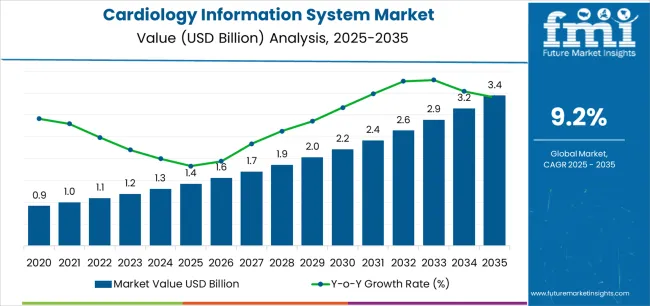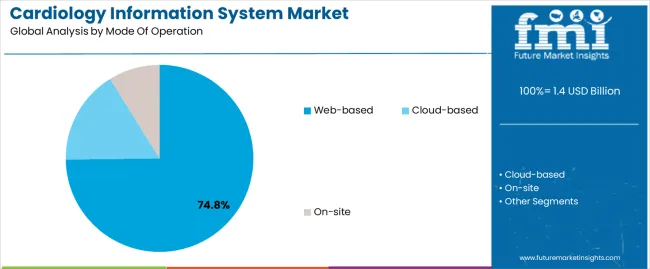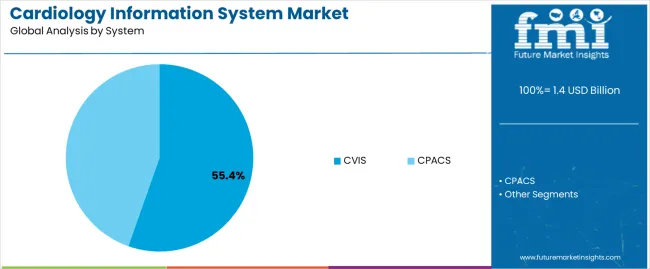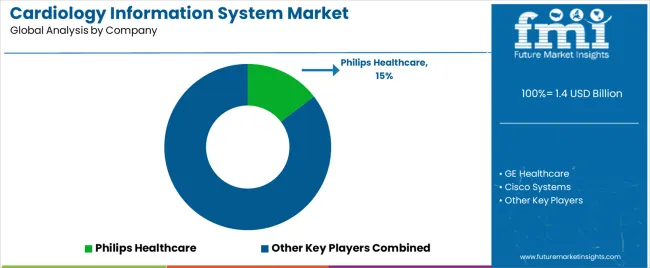The Cardiology Information System Market is estimated to be valued at USD 1.4 billion in 2025 and is projected to reach USD 3.4 billion by 2035, registering a compound annual growth rate (CAGR) of 9.2% over the forecast period.
The cardiology information system market is advancing steadily, supported by the increasing burden of cardiovascular diseases and the need for efficient digital data management in healthcare facilities. Hospitals and clinics are adopting integrated cardiology IT systems to streamline workflow, enhance diagnostic accuracy, and improve patient outcomes. Cloud-based interoperability, structured reporting, and seamless integration with electronic health records have become critical market drivers.
The focus on data-driven clinical decision-making and remote patient monitoring is fueling system upgrades globally. Additionally, healthcare digitalization initiatives and government support for electronic health infrastructure have accelerated adoption rates.
Continuous innovation in imaging software and analytics-driven diagnostic tools further enhance operational efficiency. As healthcare organizations prioritize connectivity and patient-centric care, the cardiology information system market is positioned for consistent growth.

| Metric | Value |
|---|---|
| Cardiology Information System Market Estimated Value in (2025 E) | USD 1.4 billion |
| Cardiology Information System Market Forecast Value in (2035 F) | USD 3.4 billion |
| Forecast CAGR (2025 to 2035) | 9.2% |
The market is segmented by Mode Of Operation and System and region. By Mode Of Operation, the market is divided into Web-based, Cloud-based, and On-site. In terms of System, the market is classified into CVIS and CPACS. Regionally, the market is classified into North America, Latin America, Western Europe, Eastern Europe, Balkan & Baltic Countries, Russia & Belarus, Central Asia, East Asia, South Asia & Pacific, and the Middle East & Africa.

The web-based segment leads the mode of operation category with approximately 74.8% share, supported by its cost-effectiveness, accessibility, and ease of deployment. Cloud-hosted web systems allow healthcare professionals to access and share patient information across departments and locations, improving coordination and response time.
The segment benefits from reduced IT infrastructure requirements and seamless system updates, enhancing operational continuity. Adoption is further reinforced by growing demand for remote diagnostics and telecardiology services.
With improved cybersecurity frameworks and data compliance measures, web-based solutions continue to gain preference among hospitals and diagnostic centers, ensuring their sustained dominance.

The CVIS segment accounts for approximately 55.4% share of the system category, driven by the increasing integration of cardiology-specific software solutions that centralize imaging, reporting, and patient management. Cardiovascular information systems improve workflow efficiency by consolidating multiple data sources into a unified interface, reducing duplication and diagnostic delays.
Their ability to support structured reporting, analytics, and image archiving aligns with healthcare providers’ digital transformation goals. Hospitals favor CVIS implementations for enhanced interoperability with EMR systems and long-term data storage.
With the growing volume of cardiovascular procedures and the need for comprehensive patient records, the CVIS segment is expected to retain its market leadership.
From 2020 to 2025, the cardiology information system market experienced a CAGR of 12.5%. The emphasis on interoperability within healthcare systems has driven the integration of cardiology information systems with other health information technologies, such as electronic medical records (EMR) and picture archiving and communication systems (PACS).
Seamless data exchange between different components of the healthcare infrastructure improves overall patient care. Government regulations and incentives promoting the adoption of healthcare information systems, including those in cardiology, have stimulated market growth.
Compliance with regulatory requirements and participation in incentive programs drive healthcare organizations to invest in modern information systems. Projections indicate that the global cardiology information system market is expected to experience a CAGR of 9.7% from 2025 to 2035.
| Historical CAGR from 2020 to 2025 | 12.5% |
|---|---|
| Forecast CAGR from 2025 to 2035 | 9.7% |
The provided table highlights the top five countries in terms of revenue, with South Korea and Japan leading the list. Government initiatives and healthcare policies wield substantial influence in driving the uptake of cutting-edge healthcare technologies, such as cardiology information systems in South Korea.
The ongoing progress in technology, particularly the incorporation of artificial intelligence (AI) and machine learning within healthcare frameworks, has the potential to fuel the widespread adoption of advanced cardiology information systems in Japan.
| Attributes | Forecast CAGRs from 2025 to 2035 |
|---|---|
| The United States | 10.0% |
| The United Kingdom | 10.9% |
| China | 9.8% |
| Japan | 11.2% |
| South Korea | 11.8% |
The cardiology information system market in the United States is expected to grow with a CAGR of 10.0% from 2025 to 2035. The United States has a significant burden of cardiovascular diseases. The rising prevalence of conditions such as heart disease and stroke could drive the demand for advanced cardiology information systems to manage and streamline patient data.
The United States healthcare system has been undergoing a digital transformation, with increased adoption of electronic health records (EHR) and healthcare information technologies. This trend is likely to include the integration and adoption of advanced cardiology information systems.
The prevalence of cardiovascular diseases in the United Kingdom is a key factor driving the demand for advanced cardiology solutions. The need for efficient management of cardiology-related data, including diagnostic imaging and patient records, may contribute to the growth of the cardiology information system market.
The cardiology information system market in the United Kingdom is expected to grow with a CAGR of 10.9% from 2025 to 2035.
The National Health Service (NHS) in the United Kingdom plays a significant role in shaping the healthcare technology landscape. Initiatives and investments by the NHS to modernize and digitize healthcare services may contribute to the adoption of cardiology information systems.
The United Kingdom's healthcare sector has been undergoing a digital transformation, with a focus on improving patient care through the use of digital technologies. This transformation includes the adoption of electronic health records (EHR) and other information systems, potentially extending to specialized systems like cardiology information systems.
The cardiology information system market in China is expected to grow with a CAGR of 9.8% from 2025 to 2035. China has been increasing its healthcare expenditure, and the government has implemented various initiatives to improve healthcare infrastructure and services.
This investment could contribute to the adoption of advanced healthcare information systems, including cardiology information systems.
The increasing prevalence of cardiovascular diseases in China is a significant driver for the demand for cardiology information systems. As the population ages and lifestyle factors contribute to heart-related conditions, there is a growing need for efficient management of cardiology-related data.
Government policies and initiatives aimed at modernizing healthcare services may influence the adoption of healthcare information systems. In China, the government has been actively working to enhance healthcare infrastructure and promote the use of technology in healthcare delivery.
The cardiology information system market in Japan is expected to grow with a CAGR of 11.2% from 2025 to 2035. Japan has a rapidly aging population, leading to an increased prevalence of cardiovascular diseases.
The need for efficient management of cardiovascular patient data is likely to drive the demand for advanced cardiology information systems to support diagnosis and treatment.
Japan is known for its advancements in technology and innovation. The adoption of state-of-the-art imaging technologies and the integration of artificial intelligence (AI) into cardiology information systems may be prominent trends in the Japanese market.
The cardiology information system market in South Korea is expected to grow with a CAGR of 11.8% from 2025 to 2035. South Korea has been actively adopting telemedicine and digital health solutions.
Cardiology information systems that support remote access to cardiovascular data and telecardiology consultations may align with these trends.
Government initiatives and policies in South Korea can significantly influence the adoption of healthcare information systems. The government's support for digital health initiatives and regulations may shape the landscape of cardiology information system adoption.
The below section shows the leading segment. The web-based segment is to grow at a CAGR of 9.6% from 2025 to 2035. Based on application, the CVIS segment is anticipated to hold a dominant share through 2035. It is set to exhibit a CAGR of 9.4% from 2025 to 2035.
| Category | CAGR |
|---|---|
| Web-based | 9.6% |
| CVIS | 9.4% |
Based on the mode of operation, the web-based segment is anticipated to thrive at a CAGR of 9.6% from 2025 to 2035. Web-based cardiology information systems allow healthcare professionals to access patient data and diagnostic information remotely.
This accessibility is crucial for efficient collaboration among healthcare providers, especially when dealing with complex cardiology cases that may require input from multiple specialists.
Web-based systems offer greater flexibility and scalability compared to traditional, on-premises solutions. Healthcare providers can scale their usage according to their needs and adapt the system to changes in patient volumes or organizational growth without significant infrastructure modifications.
Web-based CIS allows for real-time updates and synchronization of data across different locations. This ensures that healthcare providers have access to the most recent patient information, test results, and medical histories, contributing to more informed decision-making.
Web-based cardiology information systems are designed to integrate seamlessly with other healthcare information technologies, such as electronic medical records (EMR) and picture archiving and communication systems (PACS).
This interoperability enhances the overall efficiency of healthcare workflows and contributes to better patient care.
Based on the system, the CVIS segment is anticipated to thrive at a CAGR of 9.4% from 2025 to 2035. CVIS systems offer comprehensive data management capabilities tailored to cardiology workflows.
These systems efficiently handle various types of cardiology-related data, including diagnostic images, reports, and patient information, in a centralized and organized manner.
CVIS systems integrate seamlessly with other healthcare information systems, such as Electronic Health Records (EHR) and Picture Archiving and Communication Systems (PACS).
This integration streamlines workflows, enabling healthcare professionals to access and share relevant patient data across different departments and specialties.

The cardiology information system market is moderately competitive, with a significant presence of major players. In this dynamic environment, companies are proactively employing various strategies, including expansions, acquisitions, mergers, the launch of new products, and technological upgrades, to strengthen their market positions.
These diverse approaches are instrumental for market participants to not only broaden their market share but also to sustain and reinforce their current standings.
| Attributes | Details |
|---|---|
| Estimated Market Size in 2025 | USD 1.3 billion |
| Projected Market Valuation in 2035 | USD 3.7 billion |
| Value-based CAGR 2025 to 2035 | 9.7% |
| Forecast Period | 2025 to 2035 |
| Historical Data Available for | 2020 to 2025 |
| Market Analysis | Value in USD billion |
| Key Regions Covered | North America; Latin America; Western Europe; Eastern Europe; South Asia and Pacific; East Asia; Middle East and Africa |
| Key Market Segments Covered | Mode of operation, System, Region |
| Key Countries Profiled | The United States, Canada, Brazil, Mexico, Germany, The United Kingdom, France, Spain, Italy, Russia, Poland, Czech Republic, Romania, India, Bangladesh, Australia, New Zealand, China, Japan, South Korea, GCC countries, South Africa, Israel |
| Key Companies Profiled | Philips Healthcare; GE Healthcare; Cisco Systems; Fujifilm Medical Systems Inc.; Siemens Healthcare GmbH; Cerner Corporation; LUMEDX Corporation; Digisonics Inc.; Honeywell Life Care Solutions |
The global cardiology information system market is estimated to be valued at USD 1.4 billion in 2025.
The market size for the cardiology information system market is projected to reach USD 3.4 billion by 2035.
The cardiology information system market is expected to grow at a 9.2% CAGR between 2025 and 2035.
The key product types in cardiology information system market are web-based, cloud-based and on-site.
In terms of system, cvis segment to command 55.4% share in the cardiology information system market in 2025.






Our Research Products

The "Full Research Suite" delivers actionable market intel, deep dives on markets or technologies, so clients act faster, cut risk, and unlock growth.

The Leaderboard benchmarks and ranks top vendors, classifying them as Established Leaders, Leading Challengers, or Disruptors & Challengers.

Locates where complements amplify value and substitutes erode it, forecasting net impact by horizon

We deliver granular, decision-grade intel: market sizing, 5-year forecasts, pricing, adoption, usage, revenue, and operational KPIs—plus competitor tracking, regulation, and value chains—across 60 countries broadly.

Spot the shifts before they hit your P&L. We track inflection points, adoption curves, pricing moves, and ecosystem plays to show where demand is heading, why it is changing, and what to do next across high-growth markets and disruptive tech

Real-time reads of user behavior. We track shifting priorities, perceptions of today’s and next-gen services, and provider experience, then pace how fast tech moves from trial to adoption, blending buyer, consumer, and channel inputs with social signals (#WhySwitch, #UX).

Partner with our analyst team to build a custom report designed around your business priorities. From analysing market trends to assessing competitors or crafting bespoke datasets, we tailor insights to your needs.
Supplier Intelligence
Discovery & Profiling
Capacity & Footprint
Performance & Risk
Compliance & Governance
Commercial Readiness
Who Supplies Whom
Scorecards & Shortlists
Playbooks & Docs
Category Intelligence
Definition & Scope
Demand & Use Cases
Cost Drivers
Market Structure
Supply Chain Map
Trade & Policy
Operating Norms
Deliverables
Buyer Intelligence
Account Basics
Spend & Scope
Procurement Model
Vendor Requirements
Terms & Policies
Entry Strategy
Pain Points & Triggers
Outputs
Pricing Analysis
Benchmarks
Trends
Should-Cost
Indexation
Landed Cost
Commercial Terms
Deliverables
Brand Analysis
Positioning & Value Prop
Share & Presence
Customer Evidence
Go-to-Market
Digital & Reputation
Compliance & Trust
KPIs & Gaps
Outputs
Full Research Suite comprises of:
Market outlook & trends analysis
Interviews & case studies
Strategic recommendations
Vendor profiles & capabilities analysis
5-year forecasts
8 regions and 60+ country-level data splits
Market segment data splits
12 months of continuous data updates
DELIVERED AS:
PDF EXCEL ONLINE
Student Information System Market
Oncology Information Systems Market Analysis - Trends & Forecast 2025 to 2035
Clinical Information System Market Analysis - Growth & Forecast 2024 to 2034
Hospital Information System Market
Radiology Information System RIS Market Size and Share Forecast Outlook 2025 to 2035
Flight Information Display System Market Size and Share Forecast Outlook 2025 to 2035
Laboratory Information System Market Forecast and Outlook 2025 to 2035
Geographic Information System (GIS) Market
Airport Information Display System Market
Portable Cardiology Ultrasound Systems Market Size and Share Forecast Outlook 2025 to 2035
Critical Care Information Systems Market
System-On-Package Market Size and Share Forecast Outlook 2025 to 2035
Systems Administration Management Tools Market Size and Share Forecast Outlook 2025 to 2035
Systemic Sclerosis Treatment Market - Trends & Forecast 2025 to 2035
System on Module Market Growth – Trends & Forecast 2025 to 2035
SLE Drugs Market Insights - Growth & Forecast 2025 to 2035
Systemic Mastocytosis Treatment Market
Cardiology PACS Market
Systemic Infection Treatment Market
Information Security Consulting Market

Thank you!
You will receive an email from our Business Development Manager. Please be sure to check your SPAM/JUNK folder too.
Chat With
MaRIA